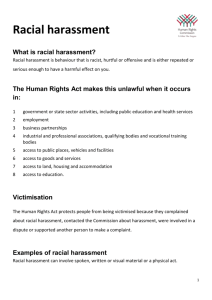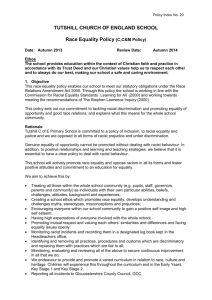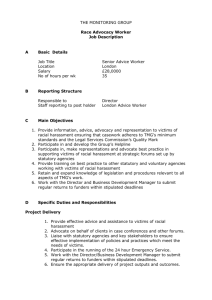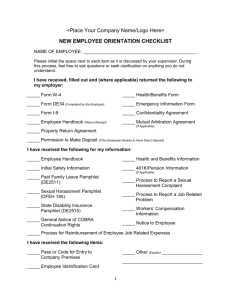2011 racial harrassment - Front Street Primary School
advertisement
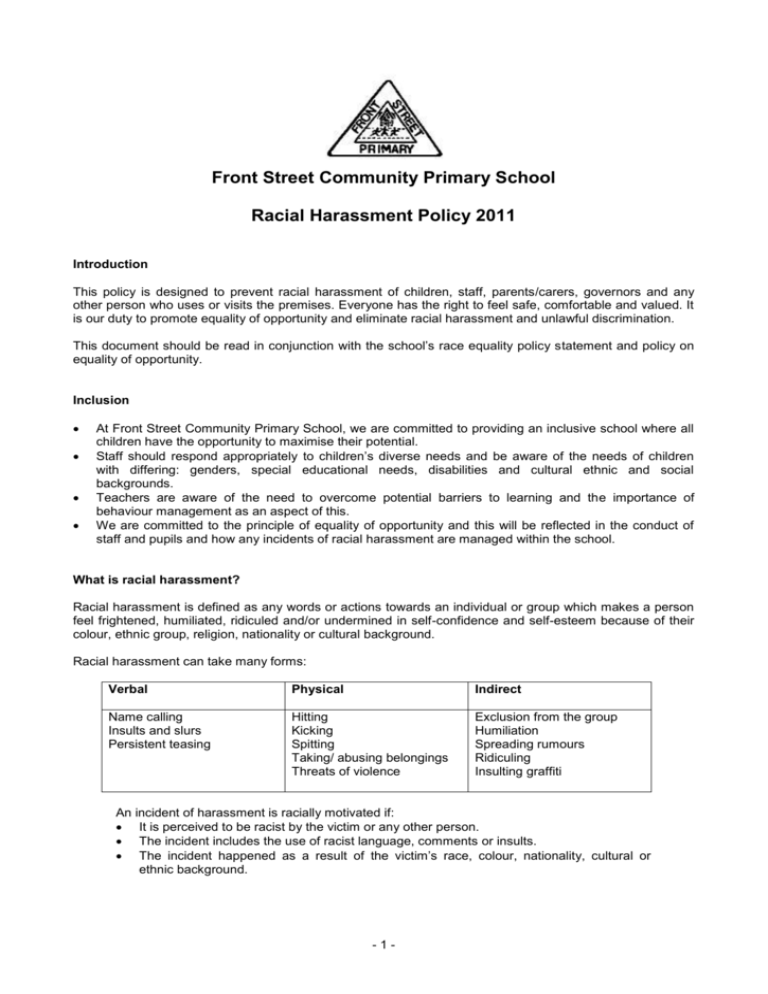
Front Street Community Primary School Racial Harassment Policy 2011 Introduction This policy is designed to prevent racial harassment of children, staff, parents/carers, governors and any other person who uses or visits the premises. Everyone has the right to feel safe, comfortable and valued. It is our duty to promote equality of opportunity and eliminate racial harassment and unlawful discrimination. This document should be read in conjunction with the school’s race equality policy statement and policy on equality of opportunity. Inclusion At Front Street Community Primary School, we are committed to providing an inclusive school where all children have the opportunity to maximise their potential. Staff should respond appropriately to children’s diverse needs and be aware of the needs of children with differing: genders, special educational needs, disabilities and cultural ethnic and social backgrounds. Teachers are aware of the need to overcome potential barriers to learning and the importance of behaviour management as an aspect of this. We are committed to the principle of equality of opportunity and this will be reflected in the conduct of staff and pupils and how any incidents of racial harassment are managed within the school. What is racial harassment? Racial harassment is defined as any words or actions towards an individual or group which makes a person feel frightened, humiliated, ridiculed and/or undermined in self-confidence and self-esteem because of their colour, ethnic group, religion, nationality or cultural background. Racial harassment can take many forms: Verbal Physical Indirect Name calling Insults and slurs Persistent teasing Hitting Kicking Spitting Taking/ abusing belongings Threats of violence Exclusion from the group Humiliation Spreading rumours Ridiculing Insulting graffiti An incident of harassment is racially motivated if: It is perceived to be racist by the victim or any other person. The incident includes the use of racist language, comments or insults. The incident happened as a result of the victim’s race, colour, nationality, cultural or ethnic background. -1- Aims To understand what racial harassment is. To provide clear guidance for dealing with racial harassment. To make everyone associated with the school policy on racial harassment. To provide a clear unambiguous procedure for dealing with incidents of racial harassment. Supporting children or adults who believe they are being racially harassed. Take all concerns seriously by: Listening carefully to complaints. Reinforcing the school’s rejection of racial harassment. Recording details of the incident. Reassure complainants that firm action will be taken against anyone who is racially harassing them. Explaining that an investigation will take place and they will be informed of the outcome. Ensuring that actions, agreed as a result of the investigation, are carried out. Dealing with any health and safety issues immediately as necessary. Procedures Always take all incidents, allegations or information seriously. Report an incident immediately to the Head Teacher or Deputy Head Teacher and an investigation should be initiated as soon as possible. Fill in an online incident report form. Provide advice and support to the complainant, including health and safety issues. Contact the Civic Centre for appropriate advice. Interview the alleged aggressor. Offer advice and support to the aggressor. Inform all parties of the outcome. In the case of proven racial harassment take necessary disciplinary action informing both sets of parents/carers as necessary. Agree a review date and monitor aggressor’s behaviour in school. Sanctions to be taken against racial harassers Pupil Parent/carer, governor, other Member of staff In accordance with school’s behaviour policy relating to serious incidents In accordance with the school’s complaints procedure In accordance with LA’s disciplinary procedure Role of the Governing Body Governors determine, support and review school policies. They support the aims of the policy by making resources available wherever possible. Governors receive termly reports, which they use for monitoring purposes. Evaluation and Review Next review: Spring 2012 -2- -3-

